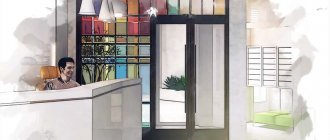5/5 (3)
Residents' rights
Citizens have the right to demand restoration of lighting in the entrance where they live from their own management company, since such an action is its direct responsibility.
The management of apartment buildings is currently carried out by specialized organizations called management companies, or associations of residents called homeowners' associations.
A special agreement is concluded between the management company and all owners of residential premises or tenants under a social tenancy agreement living in the house. To conclude it, there is no need for the signature of each apartment owner.
According to this document, each owner or tenant of residential premises is obliged to pay money to the organization, and it, in turn, must keep the common property of the house in proper condition, that is, monitor the entrance, roof, pipes, electrical wiring and other elements that are found in all apartment buildings . These responsibilities also include maintaining normal lighting in the entrances.
Where to contact
There are many reasons why the lights in the entrance may go out, and residents do not always understand who is to blame for this and what could lead to this outcome. Employees of the management company do not visit the house every day, so the best solution for residents would be to call the company on their own if the lights in the entrance go out and tell them about the problem.
You can easily find the phone number of a service organization, since all the necessary information is located in the receipts that arrive every month to pay for utilities.
According to current legislation, the management company is obliged to promptly correct all problems in the apartment building it maintains; therefore, after receiving a report of a lack of lighting, measures must be taken to restore it within a short time.
To do this, the organization must have appropriate employees on staff, or a special agreement can be drawn up with the emergency service. The telephone number by which you can call specialists is located on the receipt, and can also be found in the office of the management company.
Remember! If you cannot find the emergency number, it is better to call the service company, where you can accurately find out any telephone number you are interested in. Another option is to independently dial the emergency service itself, where you can find out whether they are servicing a particular house or not.
However, the latter option will require a lot of time, which may not be suitable for everyone.
The only effective step that residents of the house can take is to call the management company or emergency service. Further steps must be taken by these organizations. At the same time, the responsibilities of any management company include independent regular monitoring of the availability of lighting in the entrance, as well as the elimination of all difficulties that arise.
Putin signed a law simplifying the receipt of benefits for housing and communal services.
What housing and communal services repair in an apartment for free, read here.
How to pay off debt for utilities, read the link:
Automation schemes for entrance lighting
At the moment, a wide variety of automatic entrance lighting systems have been developed and implemented. Analyzing each scheme will take a lot of time, especially since they are often intertwined and combined with each other, so we will consider only the most common and, in our opinion, successful options.
After all, for each individual entrance, the most relevant will be its own lighting scheme, which takes into account the geography of the entrance, location features, number of floors of the building, the consciousness of the homeowners and many other aspects.
Lighting control using push-button stations
This method of lighting control will be successful for low-rise buildings with a sufficient number of conscious citizens. After all, it only provides an opportunity to save, and the residents of the entrance must directly implement these savings.
Its main advantage is its simplicity and price, which is significantly lower than all the options listed below.
The photo shows a possible scheme for controlling the entrance lighting using buttons
So:
- Depending on the type of entrance, this type of control has several possible options. In the first option, this is a push-button post located at the entrance to the entrance, as well as on each floor. When entering the entrance, a person presses the button to turn on the light, and the button pulls the switch to turn on the lighting of the entire entrance. When a person enters home, he presses the light off button, the starter coil is de-energized and the light goes out.
- The second option involves the possibility of turning on the lighting of only the stairwell from the push-button station. In this case, the floor corridors are switched on from individual push-button posts and act on their own starter. This option is more economical, but somewhat more difficult and expensive to implement.
Note! In most cases, instead of push-button posts, you can use circuits of so-called “pass-through” switches. This will add a bit of complexity to the electrical circuit, but can be significantly cheaper in the long run. But this option may not be suitable for all entrances.
- With this control method, basement lighting in hallways, as well as in the attic and outdoor lighting are controlled from other places. They can be selected separately. In this case, external lighting can be powered through a light sensor, and lighting of utility rooms through a regular switch.
- If there are problems with the consciousness of homeowners, then turning off the lighting can be organized using an appropriate timer. In this case, when you press the button, the starter pulls up and starts the timer. After the set time has elapsed, the timer contact drops and breaks the circuit to the starter coil. Which, in turn, leads to a blackout.
Using Light Sensors
If your entrance has fairly good natural light, then our instructions advise you to consider the option of using light sensors (see Selecting and installing light photo sensors). Of course, this option does not provide maximum savings, but it is quite suitable as an alternative to a switch.
Using a light sensor to turn on the lights
- To implement this option, it is enough to install and configure just one light sensor. Just install it in the darkest place of the entrance.
- When it darkens, the sensor will work and give an impulse to turn on the light through the starter or through its own contacts. In this case, not only the entrance lighting, but also the external lighting can turn on.
Note! Here and below we use starters to turn on the lighting. This is done on the basis that there may be currents in the lighting network that significantly exceed the rated currents of the sensors. If the current of your lighting network does not exceed 6, 10 or 16A, then you can easily use your own contacts of the corresponding sensors.
- As for lighting utility rooms, when using light sensors, it is advisable to power them through a regular switch.
Using motion sensors
Automatic lighting of entrances using motion sensors appeared relatively recently, but is confidently gaining more and more popularity. After all, it allows you to really save money and at the same time does not require any human attention. The main thing here is to organize everything correctly depending on the characteristics of your entrance.
Connection diagram for motion sensors to turn on the lighting
- For the normal functioning of such a scheme, you will need one sensor for each floor. In addition, in some cases, one sensor at the entrance to the entrance may be required.
- When a person enters the room, the sensor at the entrance is triggered. It gives an impulse to turn on the lighting starter for the staircase and first floor. If the house is equipped with an elevator, then it must give an impulse to turn on the lighting of the first floor, the passage to the elevator and the staircase. The need to supply lighting to the staircase is considered based on the characteristics of the entrance.
- Once triggered, the sensor begins counting the time until the lighting turns off. This time should be set in such a way that the person has time to slowly climb to the second floor.
- If we do not have an elevator, then a person, going up the stairs, falls into the range of sensors located on the second floor. This sensor also triggers and sends an impulse to the staircase lighting starter coil and to turn on the second floor corridor lighting. Now, even after the time of the sensor at the entrance to the entrance expires, the lighting of the staircase will not go out, since the sensor on the second floor has already triggered and created a circuit for the starter coil.
- This happens on subsequent floors until the person goes home. After this, after the time on the last triggered sensor has expired, the lighting in the staircase and in the corridor of this floor will go out.
- But if the entrance is equipped with an elevator, it is a little more difficult to implement the optimal lighting scheme with your own hands. This requires integration with the elevator industry. Ideally, when the floor button is pressed, in addition to the command for the elevator, a corresponding signal is sent to the lighting system. But this is often difficult to implement. It would be a little easier to link the switching on of the lighting to the limit switch for opening the elevator doors, but this again requires specialists.
- Therefore, the most common occurrence is that the lighting is turned on by a motion sensor when a person exits the elevator. Of course, you will have to take the first step at dusk, when the elevator lamp is insufficiently illuminated, but otherwise the implementation of lighting the entrance from motion sensors becomes much more complicated.
- But street lighting of the entrance, as well as the attic, basement and other utility rooms, is best implemented as described in the option with push-button control.
Combined lighting schemes
But often lighting in hallways and basements is combined. And here again, a lot depends on the tasks set and the type of room.
The ideal option can only be chosen according to location. But some options will be a good solution in most rooms. We present one of these below.
Principles of energy saving in multi-storey buildings
- In this version, the light sensor is used as the main one. When the light level decreases, it is triggered and sends an impulse to turn on the main starter. This starter supplies power to motion sensors and also turns on exterior, lobby, elevator shaft, and evacuation lighting.
- The main lighting of the entrance is provided by motion sensors distributed according to the scheme described above.
- The rest of the lighting is switched on using conventional or pass-through switches.
If the light is not on due to non-payment
As a rule, the tenant pays for electricity twice. The first time is for electricity spent in your own apartment, the second time is for electricity spent on general household needs. In different regions, the mechanism for collecting payments for common household needs (general household needs) is carried out differently.
Somewhere people pay for electricity in the entrances directly to the resource supply company. This method sometimes does not fully comply with legal norms. But options to make it look legitimate exist, and organizations are taking advantage of them.
In some regions, the collection of money for ODN is carried out by the management companies themselves, and only after that they pay the energy companies.
In both cases, it should be remembered that turning off electricity at the entrance due to incomplete payment is unlawful.
It is enough that there is at least one tenant who has paid the ODN bill for organizations to be obliged to provide electricity. Each resident citizen has his own relationship with the management company or the company that provides electricity.
Technical reasons
In accordance with Federal Law No. 261-FZ dated November 23, 2009, the energy company supplies electricity to a specific house. The further fate of electricity is already a problem for the management company or HOA.
Article 161 of the Housing Code states that common property must be in a condition that can ensure the safety of life and health, accessible use of common premises and the constant readiness of engineering and communication networks (water pipes, sewer network, electrical networks, etc.). The lack of lighting in entrances due to technical problems contradicts all three categories.
At the same time, Decree of the Government of the Russian Federation dated August 13, 2006 N 491 (this regulatory act establishes the mechanism for the operation of management companies and homeowners' associations) and its annexes declare that minor repairs of electrical appliances and maintaining the electrical wiring of the house in working condition are the responsibility of the organization that services house. Therefore, the lighting in the entrance must work, and the management company must control this.
Watch the video. How to make a management company work:
Lighting in the entrance of an apartment building
For any homeowner organization, lighting in the entrance is a very significant expense item. There are a number of norms and rules that it must comply with. All of them are clearly described in GOST and are standardized in accordance with VSN 59–88 and this is the law.
Here are their main requirements required by law:
- A general lighting system must be used in all public spaces and buildings;
- Any residential building higher than six floors, or if it houses 50 people or more, must have special evacuation lighting. These evacuation lamps must be installed along the lines of the main passages and on areas in front of the elevators;
- In case of fire, lighting lines should be connected to the network of the evacuation lighting system, and its intensity should correspond to the standard;
- In accordance with the table specified in this document, all lighting is normalized based on its classification, that is, fluorescent (daylight) or using, already slightly outdated, incandescent lamps. The lowest illumination on staircases in entrances and floor corridors should be no lower than 10 Lux when illuminated by fluorescent light sources, and no less than 5 when illuminated by incandescent lamps. These lighting systems should illuminate landings, staircase steps, and corridor floors. If the lighting of staircases is carried out in combination, that is, with these two types of lamps, then the calculation of the minimum illumination should be calculated according to the luminescent type, which means at least 10 Lux.
However, over the past few years, the technology for the production of lamps and lighting systems has stepped forward and with the advent of LED lamps, as well as the reduction in the cost of these products, new horizons are opening up in lighting entrances and staircases. LED light sources used for lighting have a number of advantages not only in relation to incandescent lamps, but also in comparison with fluorescent devices that emit light. They can also be equipped with motion and light sensors, which allows you to further save energy costs, and therefore money, on lighting public multi-apartment buildings.
It is recommended to equip any lamp with an anti-vandal system, that is, either strong anti-shock glass or a metal grille protecting the lamp shade.
Recording requests
Companies serving the house are required to keep special logs of applications. This facilitates the prompt elimination of faults and damage, and also allows you to control the quality of the services provided.
The period for correcting problems is seven days from the moment a complaint about a malfunction is received. The management organization is responsible for the maintenance of the property, which includes the electrification of the entrances.
If a light bulb in a hallway burns out, the company must replace it. Elimination of such a problem can be carried out as part of a scheduled inspection or at the request of citizens living in the entrance. If such work is not carried out within the established time, this is considered a violation.
Important! In case of such inaction, the service organization can be held administratively liable. In such a situation, a fine of four to five thousand rubles may be imposed on officials; for legal entities it will be from forty to fifty thousand rubles.
WHAT'S IN THE LAW?
According to Presidential Decree No. 535 of December 31, 2015 “On the provision of housing and communal services,” residents pay for lighting in common areas. At the same time, they pay only for the electricity actually consumed, the consumption of which is recorded by the meter. But ensuring proper lighting of public areas is the task of utility workers.
If there are no lamps in the entrance or they are faulty, the consumer has the right to contact the housing maintenance service with a statement. ZhES employees will repair and replace the lamps free of charge. More precisely, this service is already included in the “fat” in the “Maintenance” column, and there is no need to pay additionally for it.
Article on the topic
Not up to the light bulb. How to save energy
As explained to AiF in the contact center of the housing and communal services in Minsk, an application to replace a light bulb in an entrance is usually completed within one working day. The duration of lamp repair may be longer depending on the type of failure. At the same time, the specialist added that if there is such a desire, residents can replace the light bulb themselves, but in this case no one will reimburse them for its cost.
If a light bulb or lamp is stolen, then utility workers must also return it to its place. If the thief is caught, he will most likely face administrative liability.
Self-replacement
A situation often occurs that residents of houses do not even think about who is responsible for replacing the light bulbs. Because of this, they do such work in-house, although in such cases they should contact a service company. Citizens living in the house are interested in keeping the entrances clean and bright.
Some people simply don’t want to waste time arguing with the management company. In this case, the light bulbs are replaced independently.
If a light bulb burns out frequently, your neighbors may start changing it one by one. However, all these steps are unnecessary.
It must be remembered that every month residents pay for the maintenance of the house, and the replacement of light bulbs is included in the list of services provided.
That is, the service organization must:
- carry out periodic scheduled inspections, eliminate the slightest problems with lighting. In particular, replacing light bulbs;
- troubleshoot electrical appliances.
Replacing light bulbs yourself
Many citizens simply do not think about who should change the light bulbs in the entrance.
They strive to improve everyday life, including in the hallways. But at the same time, residents of multi-storey buildings often do not want to spend a lot of time fighting with management companies.
So they simply change the bulbs themselves or insert them when they are not there. Sometimes this is done by residents of only one apartment, sometimes neighbors agree and change the light bulbs one by one.
In any case, such actions are not justified. Do not forget that tenants contribute funds for the maintenance of common property every month when paying utility bills.
As part of this service, the management company or HOA is obliged to:
- carry out periodic scheduled inspections and eliminate minor lighting problems (including replacing burnt out light bulbs);
- Troubleshoot minor electrical faults.
If the application remains unanswered
Often, citizens living in houses have to deal with situations where the management company does not respond to their requests. She ignores messages and calls from residents of the apartments of the building she is obliged to service. What should residents do in this case?
You can complain to the following institutions:
- to the court;
- to specialized government bodies (Housing Inspectorate);
- to supervisory authorities (Prosecutor's Office).
Please note! You should contact these institutions only after a claim has been sent to the service organization, and no response has been received, and no action has been taken on its part.
Complaint to the Criminal Code
To begin with, if you find problems with the light in the entrance, you need to send a complaint to your management company. It should indicate the residents’ demand to return the lighting, and even if it is clear that the company simply will not pay attention to this complaint, it still needs to be drawn up and sent.
In this case, it will be possible to confirm at a court hearing that the company is irresponsible, and even the complaints sent by the residents are not able to move them to action - fixing the lighting.
Such an appeal must be documented, otherwise it will not have any effect. There are two effective ways to do this.
Contacting supervisory authorities
If the service organization does not want to fulfill its obligations, then it can be brought to administrative responsibility, so after the period for voluntary correction of the situation has passed, you can safely contact the supervisory authorities.
The sad fact is that many people simply have no idea where to turn. In such situations, you first need to contact the State Housing Inspectorate, as well as Rospotrebnadzor.
ATTENTION! Look at the completed sample complaint against the Criminal Code in the State Housing Property Inspectorate:
The procedure here is as follows:
- make an application;
- send it to the institution in person or by registered mail;
- wait for the period allotted for consideration of complaints (one month).
Contacting such institutions if there is no lighting at the entrance is only necessary as an additional measure. You should not assume that the Housing Inspectorate or Rospotrebnadzor will instantly solve the problem.
ATTENTION! Look at the completed sample complaint to Rospotrebnadzor against the Criminal Code:
Where to go if there is no lighting in the entrance of an apartment building
If there is no light or individual light bulbs burn out, you must contact the management company by phone or write a statement in writing. Repairs must be carried out as soon as possible, but in practice this is not always the case.
If officials do not respond, you can file a complaint and they will bear administrative liability, which carries a fine of 4 to 5 thousand rubles.
From the video you will learn about a simple way to prevent the theft of a light bulb from the entrance.
Entrance lighting in apartment buildings is an important safety aspect that you need to pay attention to. Residents have the right to demand immediate troubleshooting and correction of installation errors that affect the illumination of landings and staircases.







